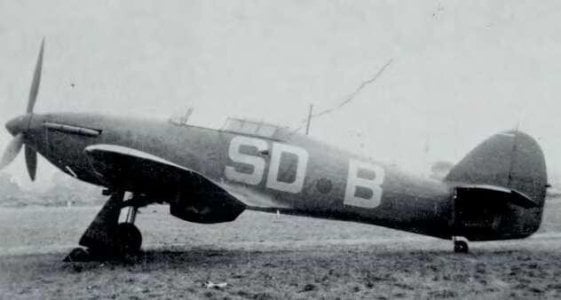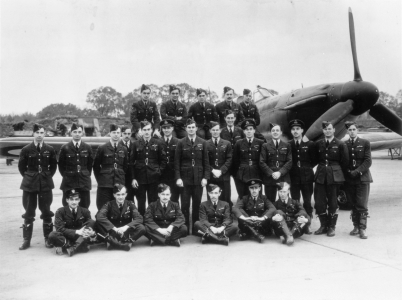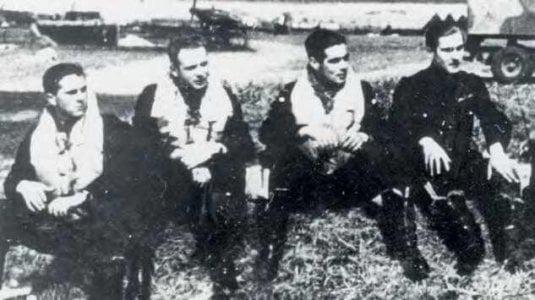My Uncle Ray
By
Aubrey Razon
- Replies 0
Note from the Editor:
This article was kindly written for the SDC by member @Doctor Alan.
It’s a very sad thing about history. It seems so fleeting and often inaccurate! We learn about the Greeks and the Romans, apparently believing every word we’re taught at school. Still, the trouble is that our own relatively recent family history looks pretty vague.
A case in point is my Uncle Ray. Ray John Kitchell Gent died at the age of 24 on January 12 1941, while ‘ferrying’ a Miles Magister aircraft from Kemble (near Cirencester) to Filton (near Bristol) in England.
The internet is a fantastic resource; without it, I would have found it quite challenging to find the above facts.
Facts and Errors:
I have found the above ‘facts’ thanks mainly to an interview with Wing Commander Paul Farnes by Melody Foreman, conducted shortly before his death in January 2020, aged 101. (I believe my paternal grandmother cherished a hand-painted picture of Ray that a colleague painted.)
While Air Force records insist that Ray died on 2nd January, it was Paul Farnes’ account that clearly stated a later date. Also, several listings of airmen who died during World War II (WW2) do not even mention Ray Gent. In addition, his demise was attributed to an ‘accident’ with no further details.
Ray’s History, according to ‘The Battle of Britain London Monument’:
Raymond John Kitchell Gent was born on 26th June 1916 at East Preston, between Littlehampton and Worthing. His parents were John Lovell Gent (1890-1962) and Edith Kate Gent (nee Kitchell, 1890-1988).
In the 1911 census, his father gave his occupation as a railway clerk. Gent joined the RAF Volunteer Reserve (RAFVR) in June 1939. Called up on 1 September 1939, he was posted to 3 ITW at St. Leonards, completed his elementary flying training at 15 EFTS Redhill, and then moved to 5 FTS Sealand for Course No. 47, which ran from 29 April to 25 July 1940. He was posted directly to 32 Squadron at Biggin Hill on 27th July 1940.
Gent arrived there with two other newly trained pilots, Sergeants TG Pickering and SAH Whitehouse. The CO, S/Ldr. J Worrall would have none of this, and after the new arrivals had made a few short flights, they were sent to 6 OTU Sutton Bridge on 3rd August. Having converted to Hurricanes, they rejoined 32 Squadron on the 25th.
Two days later, the squadron was ordered to Acklington for a rest. Worrall said that Gent, Pickering, and Whitehouse did not need a rest, and they were posted to 501 Squadron at Gravesend on the 28th.
Whilst ferrying a new squadron Magister, V1028, from Kemble to Filton on 12th January 1941, Gent crashed at Greenore, Wells after hitting some trees in low cloud and was killed.
He was 24 and is buried in St Martin's churchyard, Ashurst, Kent, where his father was stationmaster.
Interestingly, the route between Kemble and Filton is nowhere near Greenore; it is about 22 miles due south of Filton—the other side of Bristol!
The other point I’d like to make is that my brother John had somehow got hold of the idea that Ray was killed when he flew into a tethering cable of one of those blimps used for defence. This is precisely what I mean about history: it doesn’t take much to uncover discrepancies. Unfortunately, there is no longer anybody alive to set the record straight! (Paul Farnes was the last of ‘the few’).
The problem of flying in ‘low cloud’:
Low cloud cover was a significant hazard to aviation in WW2, and it was thought to have caused numerous accidents through reduced visibility and navigational errors. South East (SE) England was particularly affected by its role in air defence and bombing campaigns.
While specific records for low-cloud accidents in SE England are not provided, the meteorological conditions were documented using a coded system from 0 (worst) to 9 (best) to report visibility, cloud base height, and other factors, enabling pilots to choose safer diversion airfields.
During WW2, low cloud cover contributed to fatal accidents, such as the 1941 crash of an RAAF Avro Anson in Glenbrook, NSW, due to flying into terrain, and the 1943 B-24 crash into a gasometer near Chicago. Other crashes include a US Air Force B-25 hitting the Empire State Building in 1945 during thick fog and a B-24 bomber crashing into the Kinder Scout moors in 1944 while flying low through clouds.
Without radar, ‘accidents’ were quite common. I know from experience that when an aircraft without instruments, using what’s called ‘Visual Flight Rules’ (VFR), is not allowed to fly in clouds because in a very short time, the plane can be subject to a fatal spin, since your brain can’t tell whether the plane is level or not. (I’d had a number of lessons in an Ultralight).
Paul Farnes’ friend:
Paul Farnes’ interview revealed that Ray Gent was a valued friend, and he included several pictures of him:

HURRICANE SD-B P2760 IN ENGLAND, SPRING 1940. IN SEPTEMBER 1940, THIS AIRCRAFT WAS FLOWN BY FARNES’S FRIEND, RAY GENT, WHO CLAIMED A PROBABLE VICTORY ON A BF 109. THE AIRCRAFT WAS LOST ON SEPTEMBER 15 OVER ASHFORD, WITH PILOT OFFICER ALBERT VAN DEN HOVE D’ERTSENRIJCK KILLED ON HIS FIRST 501 SQUADRON PATROL. Image source: Dr Alan Gent.
He said: ‘In 501 Squadron, we lost about 13 pilots during the battle. I shared a room with one bloke who was quite a good friend – we were both sergeants, but he was less experienced. One day, he didn’t come back. And that was it. That was what could happen. That was Ray Gent. He was not in France with me, so we didn’t get hugely close – he was 24. Gent’s death was the result of a flying accident on January 2, 1941.'
(So was it January 2 or January 12?)
He said of the young pilots: ‘It was not unusual for them to come to our squadron with just four or five hours on Hurricanes. They had only just learned how to fly it, let alone fight in it’.
The actual statistics paint a very bleak picture: During the whole war, 51% of aircrew were killed on operations, 12% were killed or wounded in non-operational accidents, and 13% became prisoners of war or evaders. Only 24% survived the war unscathed.
Final thoughts:
Of all my amazing Uncles, I regard Ray Gent most highly, though I never met him. At 24, I’d married and had a son. He’d managed to shoot down two Messerschmitts and died because technology wasn’t on his side. Such a waste.
Note from the author:
I find it so sad that so many good people are simply forgotten and left behind on our ceaseless march into the future, so to speak. It's one of those times when I really wish I'd been a bit less occupied with the rat-race and had spent more time talking to my grandmother about Ray. (She'd had four children, my father, Peter, Pat, Dianne (I think), who died in childbirth and Ray).
From the Editor:
History often feels distant and untouchable, yet the stories of our own families make it real and profoundly moving. In this week’s reflection, Dr Al shares the story of his Uncle Ray Gent, a young RAFVR pilot who died at just 24 during World War II.
It’s a piece about memory, loss, and how facts can blur with time, leaving behind both heroism and unanswered questions. Many of us have similar experiences: family members whose stories are half-remembered, or whose sacrifices deserve to be honoured.
We invite you to read, reflect, and share your own family stories in the comments below. After all, it is in remembering that we keep history alive.
Love Alan’s writing and want to read more? You might also like to read:
Country Living
Our Best Friends
The Gambling Compulsion
Father’s Days
Being Old!
It’s About Time
The Twang’s the Thang!
Being Lucky
Are We All Liars?
The Coo of the Doves, The Hiss of the Guzunder
‘Till Death Us Do Part
Living in Retirement
Alan G.’s Member Spotlight: ‘Almost Famous’
The Ice Cream Job: The Tech Guy – Dr Al
The Lucky Man: The Tech Guy – Dr Al
‘Ten Pound Pom’ Hostel Living: The Tech Guy – Dr Al
Becoming a Better Driver by Accident!
Tech Talk with Dr Al: Accessibility Aids for the Home
Flying Round the World: The Tech Guy – Dr Al
Many Happy Returns of the Day!
Reaching for the Stars!
My great-grandfather’s journal of 1908: The Tech Guy – Dr Al
Pocket Money
University Days
Nasty Words and Silly Gestures
Up-Sticks and Move Interstate!










